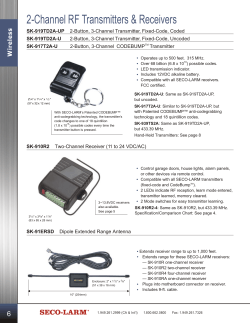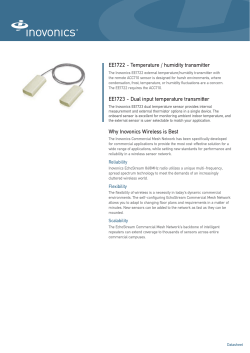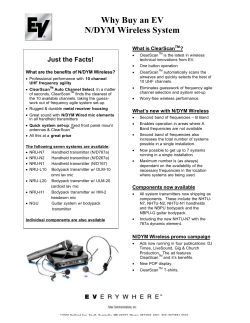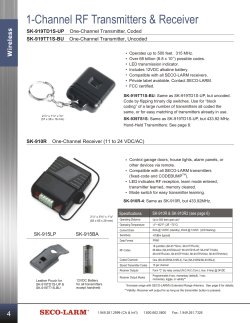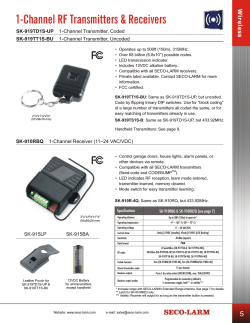
Havoc Heli AC tutorial
Air Hogs Havoc Heli AC Adapter with Battery Selector Mod Intro: First and foremost I would like to say that while this modification has worked for me, I make no guarantees that it will work for you. Furthermore, since we will be working beyond the specs of the original product, you run the risk of frying your transmitter, your heli, and almost certainly voiding any warranty you may have had... you've been warned. I would also like to note that I am no electrical engineer and in fact it's a miracle this thing worked at all. If anyone more learned than I has any suggestions or sees anything that is unsafe, please e-mail me at swedishlf@hotmail.com and I will affect changes to this guide ASAP. CAUTION: THIS MODIFICATION REQUIRES WORKING WITH ELECTRICITY AND ALL NECESSARY PRECAUTIONS SHOULD BE EXCERSIZED!!!! Now that the fun stuff is out of the way, I'd like to explain what prompted me to do this particular modification. Upon receiving my extremely fun micro heli, I managed to go through a set of 6 AA batteries every day. I can't really afford that so I started looking for AC options. All of the mods I came across online removed the ability to use batteries with the transmitter, but that was unsatisfactory to me. Thus I developed a way to give the user the option of using AC power or AA batteries. Ta da! Items needed: 1 x SPDT submini Slide Switch Radioshack #275-409 2 x Fully Insulated 9V battery snap connectors RS #270-325 1 x 9V/300mA AC adapter RS #273-1767 (Any 9V AC adapter should work if you have a spare lying around, doesn't have to be this kind) And of course you will need your Air Hogs Havoc Heli Transmitter. It also never hurts to have some extra lengths of wire lying around. Tools needed: Drill with 1/4” drill bit (any good sized bit will do) Wire cutter / stripper Soldering Iron (low wattage recommended, I used 30W without a problem) Screw driver for disassembly of transmitter Voltmeter / Multimeter is highly recommended The AC Adapter: This is the simplest part. 1. Cut the end off of your AC adapter. 2. Use the voltmeter to determine which lead is positive and which is negative. 3. Solder the black lead of one snap connector to the negative lead. 4. Solder the red lead of the snap connector to the positive lead. 5. Apply electrical tape judicously: I'd like to note that in hindsight it actually makes more sense to solder the black lead of the snap connector to positive and vice verse. If you did it this way you could (in theory) use the 9V ac adaptor to power any given device which is usually powered by a 9V battery. For consistency though I will proceed throughout the guide using my own, less logical setup. The Transmitter: 1. Remove the batteries. 2. Remove all 4 screws in the back of the transmitter. 3. Carefully remove the top cover from the bottom cover, note that there are tabs on the left and right hand sides that latch onto the top half of the transmitter. Also be careful not to break any wires, there should be 3 or 4 wires holding the two halves together, the charge cable can be threaded back through its hole to give a little more freedom of motion. It is very likely that your trim button will fall out at this point. Just save it and put it back in at the end: 4. Drill a hole in the top half of the transmitter casing under the slide plate that covers the charging cable, positioning is not to critical, just be careful not to put too much strain on the wires connecting the two halves: 5. Cut the red lead of the (other) 9V snap connector down to about 1 inch, and solder it to one of the outside connectors of the slide switch: 6. Thread the black lead of the snap connector through the hole you drilled (from the front) and solder it to the solder pad on the lower left of the bottom half of the transmitter. It can get a little tight at this point, but short wires help keep it looking tidy: 7. Desolder the black lead to the lower right pad on the bottom half of the transmitter. Solder a longer bit of wire to this solder pad and thread both the new lead and the desoldered lead through the hole you drilled: 8. Solder the black lead (that you desoldered in the last step) to the center post on the switch. 9. Solder the new lead (that you soldered in step 7) to the last remaining empty post on the switch. 10. At this point, barring any testing you feel you should do, put the transmitter back together and you should be done. Usage When the switch is farthest away from the red lead, you should be on battery power and all should operate as usual: (I promise, the red light is on in that pic) When the switch is closest to the red lead, and your AC adapter is attached to the snap connector (and plugged in) you should have AC power: (It's on in that one too) And best of all, if your wires are short enough, you can actually still fit the charger cable, the snap connector, and the switch under the charger cover! Thus if the transmitter is in battery operation mode and the cover is closed, it looks and functions as though it's totally stock: Last but not least, my most used feature, charging the heli while on AC power. This makes my batteries last much much much longer than they otherwise do: That's about the extent of the modification. I hope it can come in handy to some of you and happy flying! Send questions / comments to Daniel Hayes swedishlf@hotmail.com
© Copyright 2025



